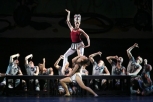Schedule of all St. Petersburg theaters on
one page >>
Please enter theatre's name, actor's name or any other keyword
Prodigal Son. Violin Concerto No 2. Russian Overture (Mariinsky II (New) Theatre, ballet) - 29 December 2024 at 17:30
Mariinsky II (New) Theatre More info | Price: 208.31 - 402.74 USD
Genre: Ballet Age restriction: 12+ Opening night: 21 May 1929
Featured in: Mariinsky II (New) Theatre December 2024 | Ballet in St.Petersburg in December 2024 | Ballet in Mariinsky II (New) Theatre in December 2024
Credits
Music by Sergei Prokofiev
Choreography by George Balanchine (1929)
Libretto by Boris Kochno (after the biblical parable)
Scenery and costumes: Georges Rouault
Scenery executed by Prince A. Schervashidze
Costumes executed by Vera Soudeikina
Staging: Karin von Aroldingen and Paul Boos
Original lighting design: Ronald Bates
Lighting: Vladimir Lukasevich
Artists
Cast to be announced
Prodigal Son was George Balanchine’s sixth ballet, staged at the Mariinsky Theatre after the ban was lifted on émigré names. By that time the dancers had already assimilated Balanchine’s complex neoclassical dance language and performed dazzlingly in that great choreographer’s plot-less ballets. But here the company had to discover Balanchine anew: because if his other works were basically formed on a modernist rethinking of the classical Russian school then Prodigal Son, created by the choreographer during his time with Diaghilev, is pure avant-garde, art of an entirely different nature. Balanchine approached the evangelical parable without any obvious piety: he staged Prodigal Son in the spirit of the age, as a montage of attractions. But despite all the hooligan-like escapades and the grotesque, the philosophical idea of the plot may be read easily, and Balanchine filled the title character with such drama and artistic truth that it has continued to attract the world’s greatest dancers for almost ninety years.
Inna Sklyarevskaya
Prodigal Son was the last work Balanchine made for Diaghilev’s Ballets russes in 1929 with Serge Lifar in the role of the Prodigal Son; it was revived in 1950 by the New York City Ballet with Jerome Robbins in the title role. Its music by Prokofiev was written for the ballet, and its costumes and décor were created by Rouault, making it a perfect example of the collaborative efforts among artists that produced some of the best works of the Diaghilev era. New for a Diaghilev ballet was the Biblical theme and the religious spirit. In seeking eternal themes and turning to past artistic devices, western artists were trying to avoid the complete intellectual and artistic degeneration towards which their rootless experimentation was leading. Prodigal Son anticipated the trend toward religion of the 1930s and 40s. It was Diaghilev’s fate that he would always be ahead of fashion, even when he believed he had turned his back on vogue. The return of Prodigal Son to St Petersburg is of great significance. For the first time, a ballet of the most radical, late period of Diaghilev’s Saisons russes has returned to the stage of the Mariinsky Theatre. That period of Russian and world ballet has come home, which until recently was under artistic (avant-garde aesthetics of the late Diaghilev era) and ideological (use of religious motifs) censorship.
With the return of Prodigal Son, the Mariinsky Theatre and its generation of young dancers have begun to restore an objective picture of the development of ballet in the 20th century.
 en
en es
es

















